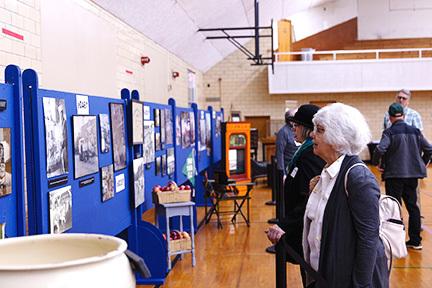Walk-Through Exhibit Celebrates Andrews History
Created in honor of the University's 150th anniversary
Campus News
| Posted on November 7, 2024

Alumni enjoyed viewing the walk-through exhibit during the 2024 Homecoming Weekend.
Andrews University continued its 150th-anniversary celebrations during its 2024 Alumni Homecoming Weekend with an elaborate walk-through exhibit, including historical artifacts and photographs. The exhibit was held in Johnson Gym on Sept. 27 and 28 and was divided by eras along the gym walls. The historical periods began with Battle Creek College, then transitioned to Emmanuel Missionary College and finally Andrews University.
Raelene Brower, director of Alumni Services, shared that the goal for the exhibit was to create an enjoyable “walk down memory lane” for alumni as well as an engaging display for current students to learn more about University history. According to Brower, the museum was a grand success.
“We received 100% positive feedback from those who visited the walk-through museum,” she says. “Our goal of evoking nostalgia about all those good memories from their days at EMC/Andrews was accomplished.”
Because of this success, Brower hopes to collaborate with the Center for Adventist Research, located on the lower level of the James White Library, to install a permanent display for anyone to visit and learn more about the 150 year history of the University.
1874 marked the start of the display, which was furnished with various artifacts and personal effects from Battle Creek College and various Adventist pioneers. Photos of the first building and students were included, as well as a complete sketch of the Battle Creek College campus. An 1892 Battle Creek College graduation diploma belonging to a student named Patience Stella Bourdeau was also on display.
The next section featured the year 1901, highlighting the move from Battle Creek to Berrien Springs via the Michigan interurban train car. Pictures of the first several students at the newly named Emmanuel Missionary College were shown. These were joined by a large college pennant printed with “Emmanuel Missionary College” and a wooden camping chair, which was also featured in a photo with an EMC student on the Berrien Springs campus.
The 1920s and 1930s section featured documents and pictures of Emmanuel Missionary College’s produce and dairy farm. The farm served as a source of revenue, as products were sold to Chicago markets, and a hub of practical academic opportunities for the agriculture-horticulture education programs. In addition to this, a 1922 diploma belonging to Mark Leon Bovee was on display.
The 1940s to 1950s portion showed the continued growth of the Emmanuel Missionary College dairy farm through a picture of Old Ned, the delivery horse for the farm, and various packages from that era with the branding of “College Dairy.” The exhibit showed that milk bottles, eggs and other products were sold from the dairy farm. Another Emmanuel Missionary College pennant was also featured in this section.
In the 1960s exhibit, a variety of photos were shown. Some indicated student activities, including students on the phone as well as classmates socializing through various activities like donkey ball, a basketball game where players were on the backs of donkeys, in Johnson Gym. Others highlighted building developments on campus, such as Pioneer Memorial Church and the Seventh-day Adventist Theological Seminary buildings. A wooden emblem of Andrews University, which contained the modern logo and motto, was also a part of the exhibit.
Andrews’ Department of Aviation and the Andrews University Gymnics program were two campus entities that had their own spotlights within the museum. The aviation department provided a photo album that allowed attendees to flip through dozens of pictures of students and faculty from 1990–1994. The exhibit also included a photo collage of the University’s planes and an overhead view of the Andrews Airpark. Physical aviation artifacts were also displayed, including a propeller blade from an Albatross plane, a model of the E-6B flight computer, an original runway light and an Andrews University wing.
The Gymnics’ exhibit featured dozens of uniforms and costumes worn by the group over the years. The exhibit also included various newspaper and magazine articles about the team, from a 1966 FOCUS magazine article to a story in The Student Movement from 2019. A unicycle and other equipment were also on display, surrounding a slideshow presentation on the history of Gymnics with photos from as early as the 1980s.
The 1980s display featured pictures of Beaty Pool, the Science Complex, mascot Andy the Cardinal, Chan Shun Hall and the ‘Til Midnight Café. The following 2000s section included photos of recent building and landscaping additions to the campus, such as the flowers in the Flag Mall, scenery between Buller Hall and Nethery Hall, the main entrance to the campus, the J.N. Andrews statue, the Andreasen Center for Wellness and the Howard Performing Arts Center. The year 2020 also had a small display, which finished off the walk-through. Pictures of students wearing masks while participating in religious and cultural events were shown, with a bottle of hand sanitizer and various styles of masks representing the pandemic-ridden year.
Brower hopes to continue to add to the collection of artifacts as it transitions to the Center for Adventist Research, such as “technology through Andrews’ history, the progression of WAUS radio facilities, something from Net ’98,” and more in the near future.
# # #
To learn more about studying at Andrews University, please visit Enrollment.
If you're interested in joining the Andrews University team, please see the list of available positions.
We invite you to support the Andrews University mission by making a donation.
Please read more about great things happening at Andrews University here.
Contact:
PR
pr@uupt.net
PR
pr@uupt.net

